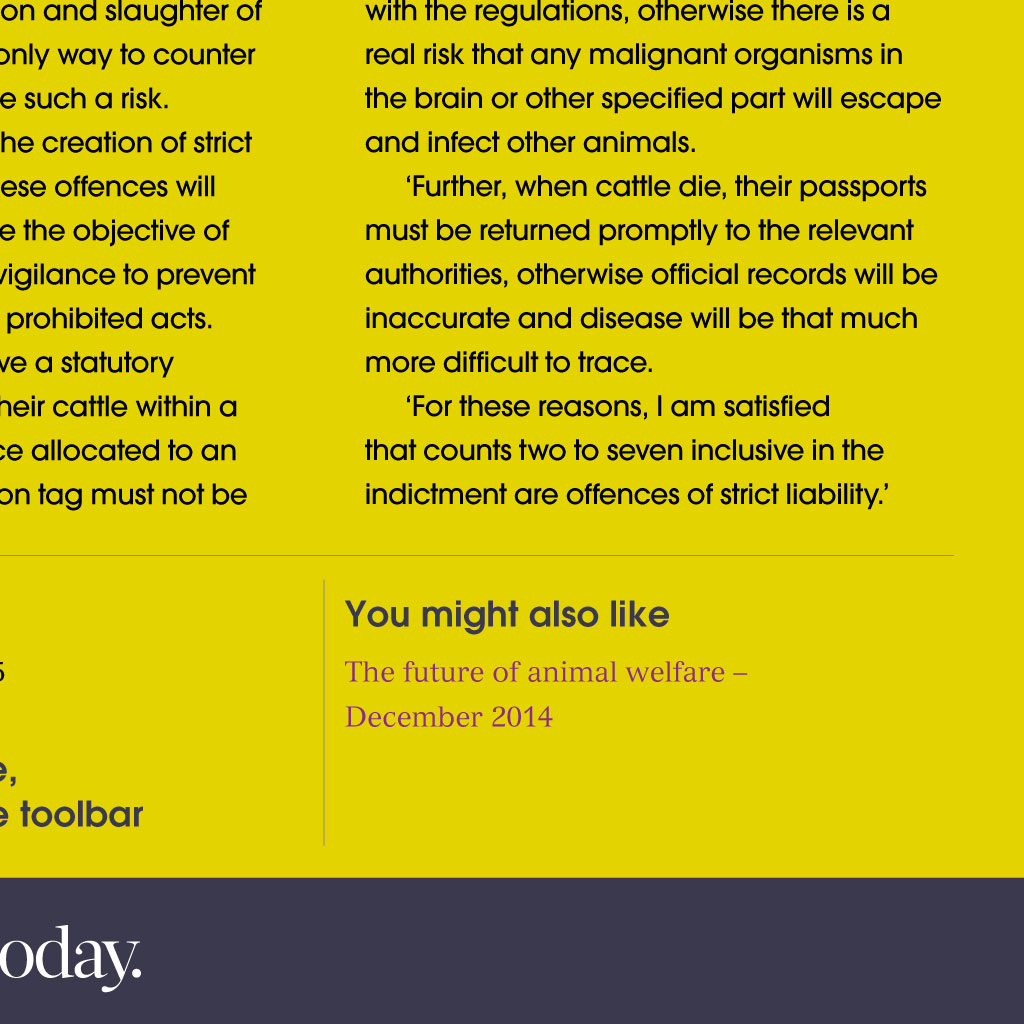













Pair of animals!

Agriculture In this feature welfare fraud case law An emaciated cow at the Collins farm in Gweek, Cornwall Pair of animals! By cracking down on the fraud and negligence of two brothers, officers in Cornwall protected the whole countrys farmers and helped to establish important case law. Rob Coston reports E maciated and lame animals; a cow stuck in a ditch and another collapsed in the farmyard; sheep carcasses that could spread disease to living animals these were just a few of the sights that awaited ofcers from Cornwalls public health and protection team on their visits to a farm in Gweek between 2012 and 2014. However, these animal-welfare violations were only part of the story; farming brothers Thomas and Paul Collins were also engaged in a fraud that put the British agricultural industry in serious peril. Stubborn On the Collins farm, inspectors found cattle, sheep and pigs that had been left untreated for lameness, not been provided with sufcient food and water, and not received veterinary treatment. The brothers had failed to prevent unnecessary suffering to animals; one downer cow* had been left in a ditch with no care, feed, water or attempts made to move her. The inspectors also discovered sheep carcasses that had not been correctly disposed of a hazard for the live animals on the farm. The Collins were advised on how to correct these issues, but chose not to do so. In fact, according to Michelle Beer, senior animal health inspector for public protection and business support at Cornwall Council, they showed extreme disregard for the welfare of their animals even after they were confronted. In addition to these offences, they committed serious fraud and endangered other farms by circumventing rules designed to prevent the spread of disease. Fraudulent Cornwall Councils public health and protection team, supported by the local Animal Health and Veterinary Laboratories Agency (AHVLA), explored an allegation that after an outbreak of tuberculosis (TB) on their farm the Collins brothers had submitted one of their cows, which had had its DNA tag cut out for compensatory slaughter, under the TB reactor removal programme. All cattle are required to have DNA tags containing a unique identication number in both of their ears. This allows vets to identify the animals a vital tool in the ght against diseases such as TB and bovine spongiform encephalopathy (BSE), commonly known as mad cow disease. Under rules introduced by the Department for Environment Food & Rural Affairs (Defra) following cases of cattle identity fraud relating to TB reactors, a vet who identies an animal as being infected with TB removes a small piece of esh from that animal, to be used as a reference sample at a later date if fraud is suspected. The lengthy investigation by Cornwall Council found that an unusual number of animals at the Collins farm had had replacement tags ordered for them over the previous 18 months. When DNA tests were carried out, it was discovered that some of the cattle were not related to their supposed mothers. An additional 24 did not have ear tags at all, making it impossible to establish their identity. This was clear evidence that fraud was taking place. If they were to stop the abuses for good, and reduce the risk of a future TB outbreak, Cornwall Council had to take the pair to court. However, the brothers stubbornness continued. Beer tried to remove TB reactors from the farm; these are cows that have shown a positive result on the tuberculin skin test, meaning they have been exposed to bovine tuberculosis and may be infected. They should be separated from other livestock to control the spread of disease, but the Collins brothers refused to let their potentially dangerous animals go. Eventually, Beer was forced to get a warrant under a TB Order to take the cattle away. The crown court trial gave us some very useful case law, which other local authority animal health functions could benefit from, concerning the question of strict liability This animal was left stuck in a ditch by the Collins brothers Smart move? When it came to prosecuting the pair, clever tactics employed by the brothers legal advisers posed a problem for Cornwall Council. The animal welfare charges were for summary offences these are usually less serious crimes, so cases can be heard by a magistrate, without the need for a judge and jury. However, deception and fraud charges in this case relating to the DNA tags are triable either way offences. This means they can be treated as summary or indictable offences, which are more serious crimes with more stringent sentences: they are usually heard at crown court. A magistrates court must decide how to treat fraud, depending on the seriousness of the case. The defence team was able to split the fraud and animal welfare offences, perhaps feeling the charges would look less serious when separated. The fraud charges were examined rst in the crown court, but this meant the welfare charges had to wait so ofcers had to continue monitoring the farm, expending time and resources as violations continued. Very few local authority animal health functions (LAAHFs) are in a position to seize animals under the Animal Welfare Act 2006 because of nancial constraints, says Beer. So we are faced with repeated visits, causing a resources drain on ofcer time for the local authority, the Animal and Plant Health Agency and in this case the police. In total, ofcers visited the farm 12 times. Guilty of fraud Few LAAHFs are in a position to seize animals under the Animal Welfare Act 2006 because of financial constraints, so we are faced with repeated visits At Truro Crown Court, Thomas and Paul Collins initially pleaded not guilty to breaching cattle identication regulations and offences relating to TB fraud. However, both men changed their pleas during the trial. Thomas Collins pleaded guilty to reusing an ear tag for a cow to which it was not assigned, failure to tag 24 calves and failure to properly dispose of sheep carcasses. In June 2014, Judge Christopher Harvey Clark QC ned him 750 for each ear-tag offence and 500 for the carcasses, plus 3,000 in costs. Paul Collins pleaded guilty to fraudulently obtaining TB compensation from AHVLA/Defra, as well as the reuse of the tag and the failure to tag the calves. He was ned 3,000 for the fraud and 500 for each regulatory offence, plus 4,000 in costs. In total, the pair were ned 6,000 and had to pay 7,000 in costs. They were given 12 months to pay in full. Not so clever The farmers found that their legal strategy had backred when they lost the animal-welfare case in March this year. At Truro Magistrates Court, they were found guilty of 17 charges of failing to care properly for cattle, sheep and pigs. Both men were sentenced to four years in prison, suspended for two years. They were also banned from keeping livestock for the rest of their lives. Wider benefits Due to the nature of the Collins brothers case, it took 12 months to get a result on the fraud and by-products, and another nine months to get the welfare cases decided, says Beer. So, were the investigation and prosecutions worth the expenditure of time and effort? The livestock ban alone is a signicant result, because the brothers negligence could have resulted in a wider outbreak of TB or another animal disease a potential disaster for British farmers. However, Beer points out that the fraud case has other signicant, national implications: The crown court trial gave us some very useful case law, which other LAAHFs could benet from, concerning the question of strict liability for both cattle identication regulations and animal by-product offences. (See panel, Strict liability.) This case has brought further clarity and will help ensure that others who commit this kind of fraud for personal gain or to disguise negligence will not try to hide behind ambiguity in the law. References: *A downer cow is a cow that, on examination, ought to rise, but doesnt. www.thecattlesite.com S TRICT LIABILIT Y When passing sentence at Truro Crown knowledge that, within very recent times, transferred to another animal, otherwise Court, Judge Harvey Clark QC stated: there has been immense public concern misidentification occurs and the control of [The brothers legal representatives] have over the risk of BSE being transferred to disease is severely affected. submitted that the Cattle Identification humans in the form of Creutzfeldt-Jakob Regulations are not, at least primarily, disease, the so called mad cow disease. animals, this has to be done in accordance concerned with public safety. Mr Ticehurst The precise identification and slaughter of with the regulations, otherwise there is a argued that they may well have been diseased cattle is the only way to counter real risk that any malignant organisms in principally concerned with regularising and perhaps eradicate such a risk. the brain or other specified part will escape cattle for the purpose, for example, of I am satisfied that the creation of strict As for the disposal of carcasses of dead and infect other animals. Further, when cattle die, their passports making farm subsidy payments. Mr liability in respect of these offences will Chaplin likewise suggested that the be effective to promote the objective of must be returned promptly to the relevant regulations were more concerned with encouraging greater vigilance to prevent authorities, otherwise official records will be administration than public safety. the commission of the prohibited acts. inaccurate and disease will be that much Farmers know they have a statutory more difficult to trace. I do not accept these submissions. As I have said, the regulations were introduced, obligation to identify their cattle within a For these reasons, I am satisfied at least in part, to help control disease in short time of birth. Once allocated to an that counts two to seven inclusive in the cattle. Further, it is a matter of common animal, an identification tag must not be indictment are offences of strict liability. Credits Published You might also like Rob Coston is a reporter for TS Today. Thursday 28 May, 2015 The future of animal welfare December 2014 To share this page, click on in the toolbar

